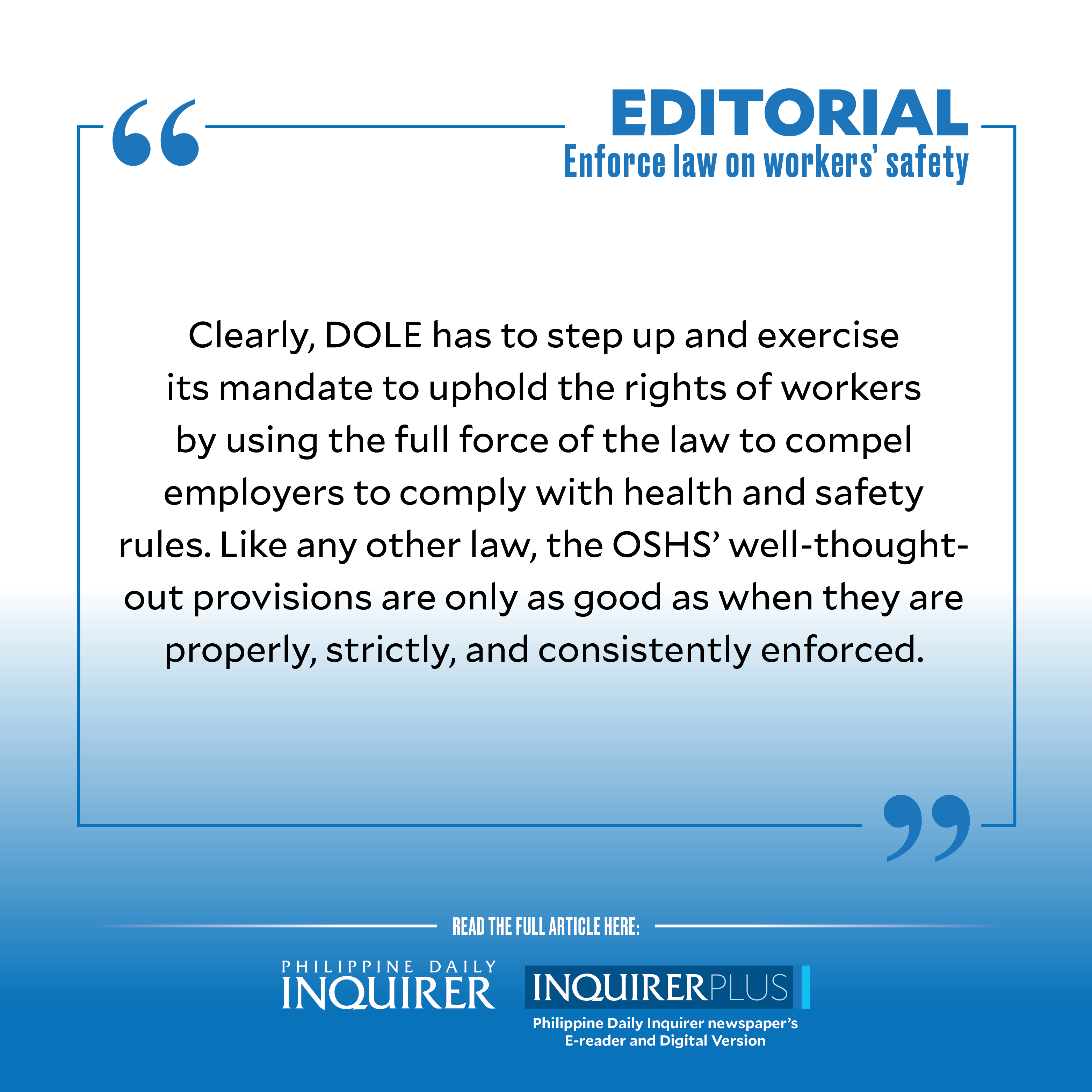
The Department of Labor and Employment (DOLE) confirmed last week what Filipinos who have seen construction projects up close can already determine for themselves: That many construction companies do not comply with basic health and safety standards, thus putting their workers at very real risk of serious injury, debilitating illness, and even death.
According to the DOLE’s Bureau of Working Conditions (BWC), 52 of the 95 or 55 percent of the construction projects that it inspected from Aug. 1 to 15 in Metro Manila alone were found to have violated basic occupational safety and health standards mandated under the OSHS law. Among the top violations were the lack of personal protective equipment (PPE) for workers that include safety shoes, helmets, harnesses, gloves, and goggles. If there were PPE, these were found to be inadequate or incorrectly used.
The inspectors—from the BWC, the Occupational Safety and Health Center (OSHC), and DOLE-National Capital Region—likewise found that some of these errant construction companies did not have designated OSHS personnel such as safety officers and first aiders.
Plus, there was no safety and health committee, no mandatory OSHS training for all workers, and no copy of the construction safety and health program in the workplace in some cases.
These are clear violations of the OSHS law put in place to make the work environment safer for workers. The law includes training requirements, the provision of safe facilities, PPEs, and on-site clinic facilities, as well as audit and tracking of compliance.
The utter disregard for the most basic occupational safety and health guidelines was particularly alarming, with DOLE identifying construction sites among “high-risk establishments,” with hazards or potential hazards present that will affect the health and safety not just of workers but also of outsiders.
Indeed, the guidelines emphasized that major accidents resulting in disability, death, or major illnesses are likely to occur among high-risk establishments if no preventive or control measures are put in place.
Given the ever-present dangers in the workplace, it stands to reason that these “high-risk establishments” should exert even greater effort than most to adhere to the rules and regulations, and more importantly, the spirit of the OSHS law.
But if the unacceptably high percentage of violators found by the DOLE inspection team were any indication, the opposite appears to be more the rule than the exception.
Unfortunately, the companies recently found violating the law appeared to have gotten away with a mere slap on the wrist, which does not help government efforts to enforce health and safety rules in the workplace.
Instead, the construction sites without PPE were merely advised to immediately procure them, while those found lacking in training were asked to go through the learning sessions, such as the 40-hour construction occupational safety and health training provided by the OSHC and DOLE-accredited safety training organizations, and the standard first aid and basic life support training for the required first aid certification.
Indeed, DOLE had merely admonished construction companies to strictly comply with the OSHS.
The OSHS implementing rules and regulations, however, imposes a penalty of P100,000 for every day of violations that expose workers to death, serious injury, or serious illness, without prejudice to the filing of any criminal or civil case.
To think that DOLE had already been called out by Sen. Joel Villanueva after two workers died following the crash of the elevator they were working on in a building in Makati City last year.
“One accidental but preventable death in the workplace is already far too many,” stressed Villanueva, principal author and sponsor of Republic Act No. 11058, or an “Act Strengthening Compliance with Occupational Safety and Health Standards and Providing Penalties for Violations Thereof.”
As circumstances stand, chances are high that more deaths from OSHS violations will follow.
Villanueva cited last year that as of April 30, 2022, only 64.6 percent of the 25,493 establishments inspected had complied with OSHS, with similar violations found such as noncompliance with the requirements of having first aiders, safety officers, and fire safety measures.
Clearly, DOLE has to step up and exercise its mandate to uphold the rights of workers by using the full force of the law to compel employers to comply with health and safety rules.
Like any other law, the OSHS’ well-thought-out provisions are only as good as when they are properly, strictly, and consistently enforced.

